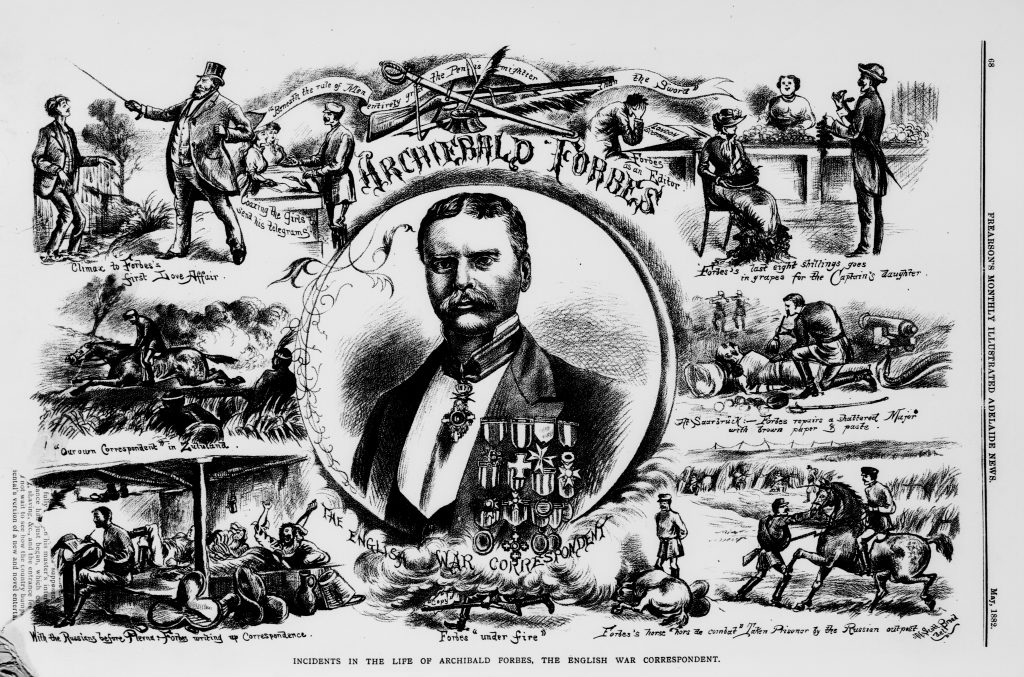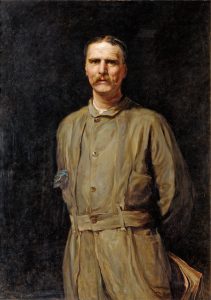Archibald Forbes (1838-1900)
Archibald Forbes’s success in using the still-new telegraph to scoop stories from the front during the Franco-Prussian War of 1870 launched him as a formidable rival to William Howard Russell of the Times. Forbes became the leading war reporter of the Daily News after its general manager, J.R. Robinson, spotted his talent. His dramatic word-painting was praised by Chambers’s Journal in 1873: ‘of the late campaign between France and Germany, we at home were almost made spectators, thanks to his graphic pen’ (‘A Versatile “Special”’, 20 September 1873, p. 597). He later attributed his success as a Special to his early career as a soldier. Indeed, the Western Mail described him on 27 April 1877 as ‘combin[ing] all the qualities of a good war correspondent – pluck and dash, tempered with discretion, the knack of writing in a graphic style under any circumstances, and not too much modesty’.
Although it was the Franco-Prussian war that first made his name, Forbes went on to report the Carlist wars in Spain, the Serbian-Turkish War, the Russo-Turkish War, the occupation of Cyprus, the Afghan War and the Anglo-Zulu War. While he reported on all manner of events, like other Specials, he was best known for his war correspondence. His ‘brilliant adventures and successes’ had, as Joseph Hatton put it, ‘surrounded his name with … a halo of journalistic romance’ (Journalistic London, p.58). Like Russell and Sala, he subsequently turned his adventurous career to further account on the lecture circuit throughout Britain, America and the Empire. An admiring review of his first lecture given in Sydney in May 1882 described the effect of authenticity conveyed to his audience: ‘The ring of his voice said unmistakeably, “I have seen what I am telling you, and I feel it now’” (‘Archibald Forbes’, Australian Town and Country Journal, 13 May 1882, p. 878).

Inspired by one such lecture, Frearson’s Monthly Illustrated Adelaide News published an illustration, by the South Australian artist, Alfred Scott Broad, featuring a central image of Forbes encircled by the most salient points of his celebrated life story. Based on an engraving of a cabinet photograph of Forbes, produced by Elliott and Fry in the 1880s, the image detailed the impressive array of medals he had received, including the Order of St. Stanislas from Russia, the Iron Cross 2nd Class for Non-Combatants, the civil class of the Pour Le Mérite and the French Legion of Honor. The illustration also heralded his work as editor of the Scotsman, the challenges of delivering copy under fire, his fortitude when taken prisoner by a Russian outpost and his daring ride in Zululand.

Taking advantage of Forbes’s manly celebrity, to gain publicity Sir Hubert von Herkomer asked his friend to sit for him as a ploy to jump-start his career as a portraitist. (A.L. Baldry, Hubert von Herkomer RA, 1901) The resulting virile image of Forbes dressed in his khaki uniform had the desired effect, causing a sensation when it was exhibited at the Royal Academy in 1881. Much admired by Henry James, in his review of ‘London Pictures’ for the Atlantic Monthly the eminent writer enthused:
It is one of those fine pictures which, besides representing an individual, represent a type – raise the individual to the significance of a type. This is the roving Englishman, the man of energy and adventure, who has left his solid footprint in every corner of the globe, and has brought back from his furthest peregrinations a fund of good spirits and good stories.
(August 1882).